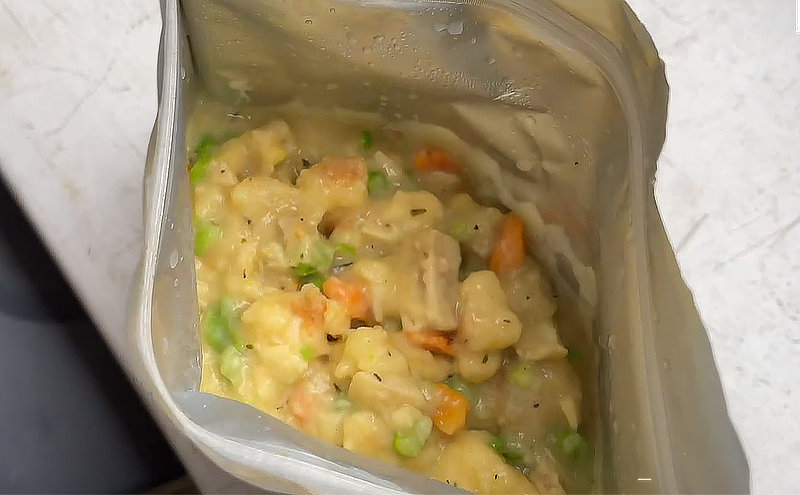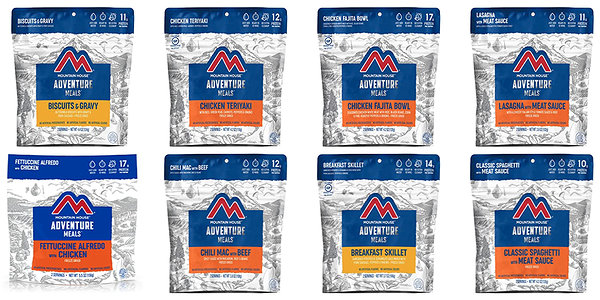Mountain House Freeze Dried Food Pouches – Calories

A list of the calories in the various pouches of Mountain House freeze dried food. It’s important to know this. Why? Because the use-case-scenario for these food pouches are those of which calories are important. Let me explain…
What do most people use Mountain House freeze dried food pouches for? They use them for their very light weight convenience, flavor, and nutritional value while hiking, camping, or any activity where these attributes are important.
There are other manufacturers of freeze dried food pouches. Why am I mentioning Mountain House? Because they have been the leader in this category. The Mountain House brand has always been considered the best in flavor and nutrition. Although I’m sure other brands compete, I decided to dig a bit deeper into the calories that you get in these pouches.
Lets say you’re hiking all day, or part of the day. Those of you who have ever gone out hiking know that the activity can be quite calorie intensive. In other words, your body consumes calories (energy units?) to get through the ordeal. And this needs to be replenished…
Ideally you’re looking for a good combination of calories and nutrition (which includes a balance of carbs and protein). While it’s relatively easy to stuff unhealthy calories into packaged foods (fillers?), the best choices are well balanced with nutrition. I believe the leading brands do a good job here.
I researched the various flavor choices from Mountain House to discover the calories in each pouch. It doesn’t matter what any manufacturer says regarding servings. Servings are arbitrary. What matters are the total calories (and nutritional value). So this is what I discovered…
Calories In A Pouch of Mountain House Freeze Dried
Sorted from highest to lowest calories per pouch
These are their latest pouches as of this post date, as far as I know. Apparently there was a redesign sometime around 2020. They’re marketed as Mountain House Adventure Meals.
| Mountain House Pouch Description | Total Calories |
| Creamy Macaroni & Cheese | 620 |
| Chicken and Dumplings | 600 |
| Chicken Fried Rice | 600 |
| Mexican Style Adobo Rice & Chicken | 570 |
| Chicken Fajita Bowl | 560 |
| Beef Stroganoff with Noodles | 560 |
| Biscuits & Gravy | 560 |
| Granola with Milk & Blueberries | 520 |
| Yellow Curry with Chicken & Rice | 510 |
| Chicken Teriyaki with Rice | 480 |
| Spaghetti with Meat Sauce | 470 |
| Chili Mac with Beef | 460 |
| Lasagna with Meat Sauce | 440 |
| Fettuccine Alfredo with Chicken | 420 |
| Beef Stew | 400 |
| Italian Style Pepper Steak | 380 |
| Scrambled Eggs with Bacon | 350 |
Did you notice something?
Some of these pouches don’t have very many calories, while others contain more. That’s important to know.
For example, lets say after a day’s hike you’re looking forward to a delicious meal. So you heat up some water with your ultralight camp stove, tear open a Mountain House pouch of Italian Pepper Steak, add the hot water, let it sit for a bit, and then eat it. A little while later you’re still hungry… That’s because there’s only 380 calories in that particular flavor pouch.
Whereas a Mountain House pouch of Chicken and Dumplings has 600 calories. That’s a difference…
In my opinion, 600 calories is probably not enough either, depending on the energy you’ve expelled during the outing. Although with that said, if it were me, I would also have a variety of food bar / protein bar snacks with me too. That would supplement well (desert?).
Mountain House Adventure Meals
(their storefront on amzn)

Check The Label For Total Calories Per Container
In conclusion, and I’ve mentioned this before, when it comes to ‘survival food’, it’s a good idea to ignore the proclaimed number of servings. Rather, check the calories (and nutrition).
Many companies (including the aforementioned) have tended to reduce the calorie content, presumably as one method to disguise inflation and/or increase margins. I still believe Mountain House to be one of the best. However pretty soon you might need two pouches to fill ‘er up (the stomach, that is)…
[ Read: Camping Gear List & Checklist of Necessary Things & Nice-to-have ]
